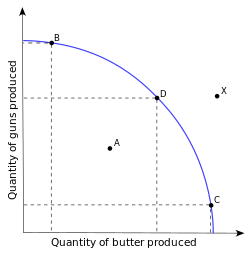In microeconomics, economic efficiency is, roughly speaking, a situation in which nothing can be improved without something else being hurt. Depending on the context, it is usually one of the following two related concepts:
- Allocative or Pareto efficiency: any changes made to assist one person would harm another.
- Productive efficiency: no additional output of one good can be obtained without decreasing the output of another good, and production proceeds at the lowest possible average total cost.
These definitions are not equivalent: a market or other economic system may be allocatively but not productively efficient, or productively but not allocatively efficient. There are also other definitions and measures. All characterizations of economic efficiency are encompassed by the more general engineering concept that a system is efficient or optimal when it maximizes desired outputs (such as utility) given available inputs.
Allocative efficiency is a state of the economy in which production represents consumer preferences; in particular, every good or service is produced up to the point where the last unit provides a marginal benefit to consumers equal to the marginal cost of producing.
Pareto efficiency or Pareto optimality is a situation that cannot be modified so as to make any one individual or preference criterion better off without making at least one individual or preference criterion worse off. The concept is named after Vilfredo Pareto (1848–1923), Italian engineer and economist, who used the concept in his studies of economic efficiency and income distribution.
Productive efficiency (or production efficiency) is a situation in which the economy or an economic system (e.g., a firm, a bank, a hospital, an industry, a country, etc.) could not produce any more of one good without sacrificing production of another good and without improving the production technology. In other words, productive efficiency occurs when a good or a service is produced at the lowest possible cost. In simple terms, the concept is illustrated on a production possibility frontier (PPF), where all points on the curve are points of productive efficiency. An equilibrium may be productively efficient without being allocatively efficient— i.e. it may result in a distribution of goods where social welfare is not maximized. It is one type of economic efficiency.
An example PPF: points B, C and D are all productively efficient, but an economy at A would not be, because D involves more production of both goods. Point X cannot be achieved.
Productive efficiency occurs under competitive equilibrium at the minimum of average total cost for each good, such as the one shown here.
Productive efficiency of an industry requires that all firms operate using best-practice technological and managerial processes and that there is no further reallocation that bring more output with the same inputs and the same production technology. By improving these processes, an economy or business can extend its production possibility frontier outward, so that efficient production yields more output than previously.
Productive inefficiency, with the economy operating below its production possibilities frontier, can occur because the productive inputs physical capital and labor are underutilized—that is, some capital or labor is left sitting idle—or because these inputs are allocated in inappropriate combinations to the different industries that use them.
In long-run equilibrium for perfectly competitive markets, productive efficiency occurs at the base of the average total cost curve—i.e. where marginal cost equals average total cost—for each good.
Due to the nature and culture of monopolistic companies, they may not be productively efficient because of X-inefficiency, whereby companies operating in a monopoly have less of an incentive to maximize output due to lack of competition. However, due to economies of scale it can be possible for the profit-maximizing level of output of monopolistic companies to occur with a lower price to the consumer than perfectly competitive companies.
Candela Citations
- Provided by: Wikipedia. Located at: https://en.wikipedia.org/wiki/Economic_efficiency. License: CC BY-SA: Attribution-ShareAlike
- Provided by: Wikipedia. Located at: https://en.wikipedia.org/wiki/Productive_efficiency. License: CC BY-SA: Attribution-ShareAlike
- Provided by: Wikipedia. Located at: https://en.wikipedia.org/wiki/Allocative_efficiency. License: CC BY-SA: Attribution-ShareAlike
- Provided by: Wikipedia. Located at: https://en.wikipedia.org/wiki/Pareto_efficiency. License: CC BY-SA: Attribution-ShareAlike


